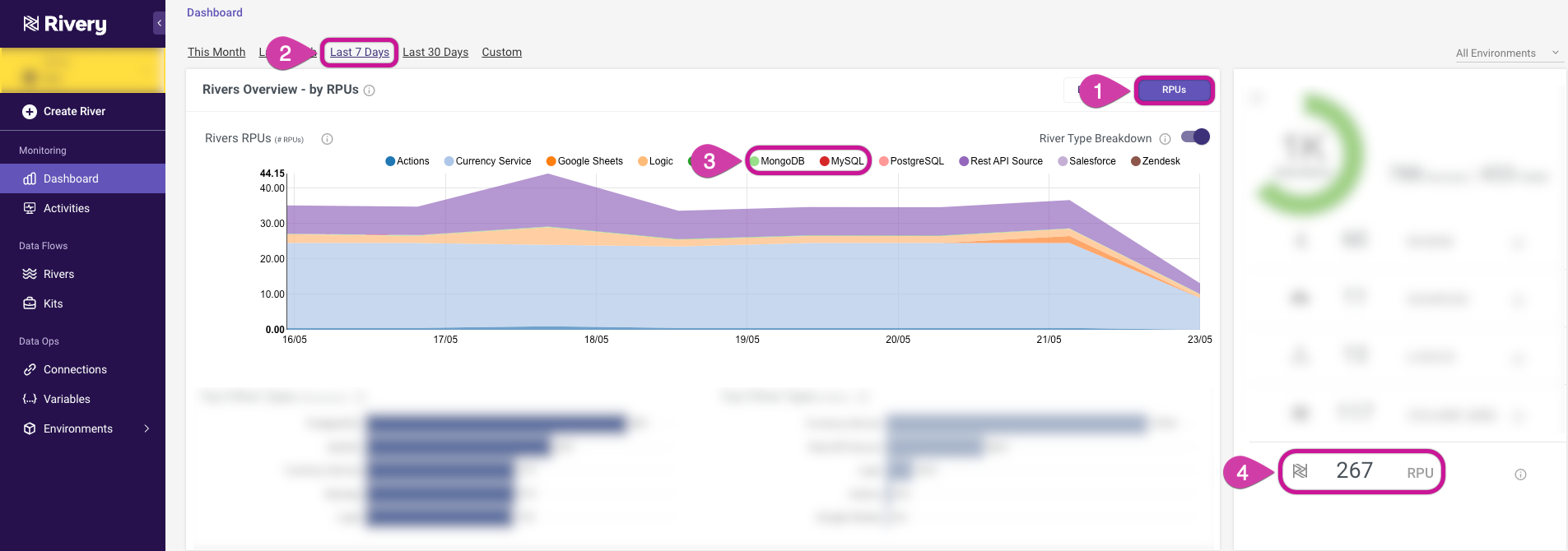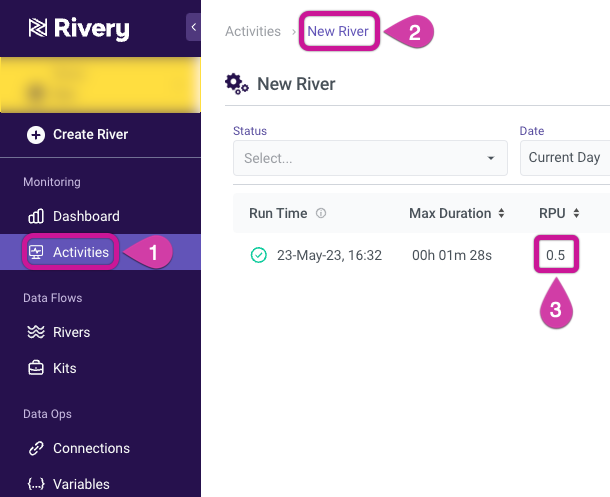- 7 Minutes to read
- Print
- DarkLight
- PDF
Pricing FAQ
- 7 Minutes to read
- Print
- DarkLight
- PDF
Rivery uses a consumption-based pricing model, where usage is measured in credits called Rivery Pricing Units (RPUs). These credits are also referred to as Boomi Data Units (BDUs).
What Is a BDU Credit?
BDU credit = Rivery Pricing Unit credit:
Database and file storage sources are charged only on the amount of data transferred down to the byte.
Most application (API) based sources are charged for each execution of a data pipeline.
Applications (APIs) with high-frequency replications can be charged on the amount of data transferred similar to databases.
We charge you based on actual usage, not number of rows, allowing you to scale in a flexible and transparent way.
Why Are Database and File Storage Sources Priced Differently from API Sources?
Data replication from database and file sources consume less compute time and therefore costs less for Rivery, so we’re passing these savings onto our customers.
How Is BDU Credit Usage Calculated?
Credit usage is based on the data source and pipeline type:
| Data Source / Pipeline Type | Credit Cost |
|---|---|
| Application (API) Based Sources | By default, you’re charged 0.5 credit every time you ingest data from a single output table. If your source is configured as a High-frequency sync source (under the Pro Plus or Enterprise editions), you’re charged 1 credit per 100MB of data transferred (pro-rata), regardless of execution frequency. |
| Database Replication & File Storage Sources | For standard database, files and webhook replication, you’re charged 1 credit per 100MB of data transferred (pro-rata), regardless of execution frequency. For log based CDC database replication, you’re charged 2 credits per 100MB of data transferred (pro-rata), regardless of execution frequency. |
| Orchestration & Advanced Workflows (Logic and Transformations) | You’re charged 0.5 credit for every execution of an entire workflow. |
Here are some examples:
| Scenario | Credit Cost |
|---|---|
| Ingesting deal information from your CRM once every 24 hours. | 0.5 credit a day |
| Ingesting both deal info & contact info (which have different output tables) from your CRM every 8 hours, but just Mon-Fri | 15 credits a week. 2 output tables * 3 times a day * 5 times a week * 0.5 BDU per execution = 15 |
| Running an orchestration workflow that pulls data from 5 different API sources, once a day. | 3 credits a day. 5 API pulls * 0.5 BDU per execution + 1 advanced workflow * 0.5 BDU per execution = 3 |
| You transfer 1,725MB of data per month between your Postgres database and your data warehouse. | 17.25 credits. 1,725MB / 100MB = 17.25 |
| You transfer 280MB of data per month from files on SFTP servers to your data warehouse. | 2.8 credits. 280MB / 100MB = 2.8 |
Please note:
Simple 'Source to Target' pipelines do not require setting up a workflow to execute.
Application (API) based sources output tables are referring to different API calls required for the same source to pull different data entities. For example, if your data source is a CRM, there may be separate API output tables to pull both deal info & contact data.
For application (API) based sources, pipelines that transfer more than 100MB of data per execution, one credit will be charged per 100MB of data. For example, 1 credit for an execution of up to 100MB of data transferred, 2 credits for an execution of 100MB - 200MB, etc. If no data is detected in the execution, the charge will be 0.5 credit.
Databases and Storage based sources (such as S3, GCS, Azure Blob, and SFTP) calculate Rivery Pricing Units (BDUs) based on data volume. Essentially, if there is no data (0 data), it translates to 0 credits.
• If you subscribed before April 1st, 2025, please refer to the legacy documentation for accurate information regarding your database plan.
• If you subscribed on or after April 1st, 2025, the current page contains the relevant details for your database plan.
How Is Python BDU Calculated?
The BDU of the Python Logic Step is calculated by adding the script's entire time and the quantity of network usage.
The Python Logic Step BDU (logicode_bdu) will be charged regardless of the run status of the Logic Step.
The python pricing is based on:
- Execution time of the user’s Python script (seconds)
- Server size they chose to execute the script (see below)
- Network bandwidth - 0.4 BDU for every 100MB of data transferred
| Server Size | BDU per Minute | BDU per Hour |
|---|---|---|
| XS | 0.021 | 1.2 |
| S | 0.041 | 2.5 |
| M | 0.082 | 4.9 |
| L | 0.165 | 9.9 |
| XL | 0.329 | 19.7 |
| XXL | 0.3884 | 23.304 |
| XXXL | 0.492 | 29.52 |
Pricing Editions Table
In the Pricing Editions Table, the letter “V” indicates that a specific plan includes the feature listed in that row.
For example, if a “V” appears under the Pro Plus column next to “AWS PrivateLink / Azure Private Link”, it means that this feature is included in the Pro Plus plan.
| Account | Base | Professional | Pro Plus | Enterprise |
|---|---|---|---|---|
| Users | 2 | Unlimited | Unlimited | Unlimited |
| User Roles & Permissions | V | V | V | V |
| User Teams | V | V | ||
| Runtime Environments | 1 | 2 | 3 | Unlimited |
| Usage | Unlimited | Unlimited | Unlimited | Unlimited |
| Database Migrations | V | V | V | V |
| Connectors & Integrations | Base | Professional | Pro Plus | Enterprise |
|---|---|---|---|---|
| Data Sources (200+) | All | All | All | All |
| Targets | All | All | All | All |
| Multiple Targets | V | V | V | V |
| Kits (pre-built workflows) | V | V | V | V |
| Reverse ETL | V | V | V | V |
| Change Data Capture (CDC) | V | V | V | V |
| API High-frequency syncs | V | V | ||
| SQL Transformations | Unlimited | Unlimited | Unlimited | Unlimited |
| Python Transformations | Unlimited | Unlimited | Unlimited | |
| Max Sync Frequency | 60 min | 15 min | 15 min | 5 min |
| Extensibility | Base | Professional | Pro Plus | Enterprise |
|---|---|---|---|---|
| Build Your Own Data Source | V | V | V | V |
| Custom Targets / Actions | V | V | V | V |
| Webhooks / Events | V | V | V | V |
| Rivery API Call Access | V | V | V | |
| Command-Line Interface | V | V | V |
| Orchestration | Base | Professional | Pro Plus | Enterprise |
|---|---|---|---|---|
| Advanced Scheduling | V | V | V | |
| Execution Logic & Branching | V | V | V | V |
| Sub-Rivers | V | V | V | V |
| Pipeline Dependencies | V | V | V | V |
| Built-In Versioning | V | V | V | V |
| Execution Logs | V | V | V | V |
| Monitoring & Alerts | V | V | V | V |
| Security | Base | Professional | Pro Plus | Enterprise |
|---|---|---|---|---|
| SOC 2 (Type II) & HIPAA | V | V | V | V |
| Custom File Zone | V | V | V | |
| SSH Tunnel | V | V | V | V |
| Reverse SSH Tunnel | V | V | ||
| AWS PrivateLink / Azure Private Link | V | V | ||
| VPN (for database integration) | V | |||
| Single Sign-On (SSO) | V | V | ||
| Audit Log | V | V |
Where Can I Find Details About My BDU Usage?
There are 2 areas where you can get information about your BDU consumption:
- Dashboard
- Activities
Dashboard
When you click the Dashboard tab from the main menu, a graph of your entire activity appears. To check your BDU usage, follow the instructions below:
- Click the BDUs tab in the upper right corner.
- Select the desired timeframe in the upper left corner of the screen.
- Pick one or more sources under Rivers BDUs, to examine BDU consumption for these specific Rivers.
- The total amount of BDU for this timeframe is indicated in the bottom right corner.

Activities
Follow these steps to check your BDU usage from the Activities tab:
- Click the Activities tab from the main menu.
- Find your River.
- On the right, you'll see the entire amount of BDU.

Python BDU
The Logic steps icon can only be found in a Logic River that uses Python. Following the previous instructions, take the next steps:
Click on the row that highlights the River
Download Logs.

- To locate the Python BDU's calculated in this run, search for "logicode_bdu_per_step".
What’s included in the Free Trial?
Rivery’s free trial includes access to all of the professional plan features, for 14 days or 1,000 free credits (worth $1,200) of usage, whichever expires first.
When your trial period ends, you can continue using Rivery by registering for any on-demand plan, or by contacting us to explore our annual and Enterprise plans.
Does Rivery Charge per Connector?
No, Rivery does not charge per connector and there is no minimum or maximum on the number of connectors you can use. We believe in providing you with the best single source to efficiently align your data from internal databases and third-party platforms.
Does Rivery Charge per User?
No, Rivery does not charge per user.
The Base edition is limited to 2 users.
All other editions includes unlimited users.
Does Rivery Charge per Environment?
No, Rivery does not charge per environment, although each plan has a maximum number of environments:
The Starter plan is limited to 1 environment.
The Professional plan is limited to 3 environments.
The Enterprise plan includes unlimited environments.
Is There a Minimum Number of API Integrations Required?
No, there is no limit to how many API integrations an account can have.
Are All Data Sources Available on All Plans?
Yes, all of our data sources are available on all plans.
Can Rivery Connect to Custom Sources?
Yes! You have multiple options for connecting to practically any source, in addition to Rivery's managed sources. Learn how.
How Do I Upgrade My Plan?
Our Subscription & Billing document shows you how to accomplish it.
What if I Have More Pricing Questions?
Please reach out to our sales team directly, we’d be more than happy to help.

